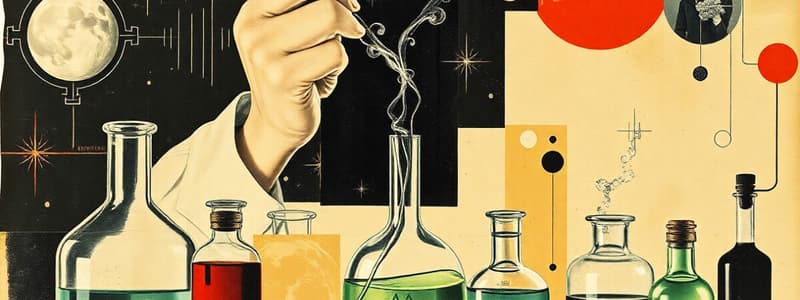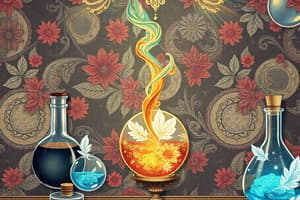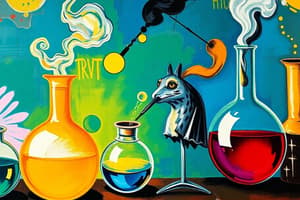Podcast
Questions and Answers
Which of the following best describes the role of carbon dioxide in baking?
Which of the following best describes the role of carbon dioxide in baking?
- It causes the dough or batter to rise, creating a light texture. (correct)
- It acts as a preservative, extending the shelf life of baked goods.
- It enhances the flavor and sweetness of the final product.
- It provides a source of energy for the other chemical reactions.
A scientist is developing a new type of biodegradable plastic. Which branch of chemistry is MOST likely involved in this project?
A scientist is developing a new type of biodegradable plastic. Which branch of chemistry is MOST likely involved in this project?
- Physical chemistry
- Inorganic chemistry
- Organic chemistry (correct)
- Analytical chemistry
Which of the following distinguishes pure chemistry from applied chemistry?
Which of the following distinguishes pure chemistry from applied chemistry?
- Pure chemistry uses complex equipment, while applied chemistry aims at using simple and cost-effective instruments.
- Pure chemistry is conducted in academic settings, while applied chemistry is exclusive to industrial settings.
- Pure chemistry focuses on immediate, practical applications, while applied chemistry seeks fundamental knowledge.
- Pure chemistry investigates fundamental chemical principles, while applied chemistry focuses on solving specific problems. (correct)
A researcher is studying the rate of a reaction at different temperatures and pressures. This research falls under which discipline of chemistry?
A researcher is studying the rate of a reaction at different temperatures and pressures. This research falls under which discipline of chemistry?
Which of the following tasks would an analytical chemist MOST likely perform?
Which of the following tasks would an analytical chemist MOST likely perform?
A scientist is investigating how a particular enzyme in the human body breaks down a specific type of fat. Which field of chemistry is this MOST closely related to?
A scientist is investigating how a particular enzyme in the human body breaks down a specific type of fat. Which field of chemistry is this MOST closely related to?
A materials scientist is creating a new semiconductor using elements from the periodic table, but not carbon. Which branch of chemistry is MOST applicable?
A materials scientist is creating a new semiconductor using elements from the periodic table, but not carbon. Which branch of chemistry is MOST applicable?
Which of the following is an example of chemistry at the macroscopic level?
Which of the following is an example of chemistry at the macroscopic level?
A research group discovers a new element and characterizes its properties, such as melting point, boiling point, and reactivity with other substances. Which area of chemistry is involved?
A research group discovers a new element and characterizes its properties, such as melting point, boiling point, and reactivity with other substances. Which area of chemistry is involved?
A company wants to optimize the yield of a chemical reaction in its manufacturing process. Which type of chemist would be MOST helpful?
A company wants to optimize the yield of a chemical reaction in its manufacturing process. Which type of chemist would be MOST helpful?
Flashcards
Science
Science
The principled, rigorous study of the natural world, encompassing many interconnected disciplines.
Chemistry
Chemistry
The study of matter and its properties as well as how matter changes.
Macroscopic
Macroscopic
Visible to the naked eye; deals with large-scale properties and observations.
Microscopic
Microscopic
Signup and view all the flashcards
Pure Chemistry
Pure Chemistry
Signup and view all the flashcards
Applied Chemistry
Applied Chemistry
Signup and view all the flashcards
Analytical Chemistry
Analytical Chemistry
Signup and view all the flashcards
Organic Chemistry
Organic Chemistry
Signup and view all the flashcards
Study Notes
- Cooking and baking are examples of chemistry in daily life, such as the reaction of baking powder and baking soda to produce carbon dioxide, which causes the rising of baked goods.
- Following specific procedures is crucial in both baking and chemistry to achieve desired results.
- Chemistry involves learning about various chemicals and reactions that are part of everyday life.
- The first chapter introduces the basics of chemistry and the scientific method.
What is Chemistry?
- Chemistry is defined and its relationship to macroscopic and microscopic perspectives are defined.
- Pure and applied chemistry are related.
- The five primary disciplines of chemistry are identified and described.
- Some modern world concerns where chemistry plays a vital role are described.
Lesson Vocabulary
- Analytical chemistry: The study of the chemical composition of materials.
- Applied chemistry: Chemistry directed toward a specific practical goal or application.
- Biochemistry: The study of chemical processes within living organisms.
- Chemistry: The study of matter and its properties, as well as how matter changes.
- Inorganic chemistry: The study of substances that do not contain carbon.
- Macroscopic: Visible to the naked eye.
- Matter: Anything that has mass and takes up space.
- Microscopic: Too small to be seen with the naked eye.
- Organic chemistry: The study of substances that contain carbon.
- Physical chemistry: The study of the physical properties of chemical substances.
- Pure chemistry: Chemistry that seeks new knowledge for the sake of knowledge.
Definition of Chemistry
- Science is the principled, rigorous study of the natural world, encompassing many interconnected disciplines.
- Physics is the study of motion and forces.
- Biology is the study of living organisms.
Studying That Suits You
Use AI to generate personalized quizzes and flashcards to suit your learning preferences.




